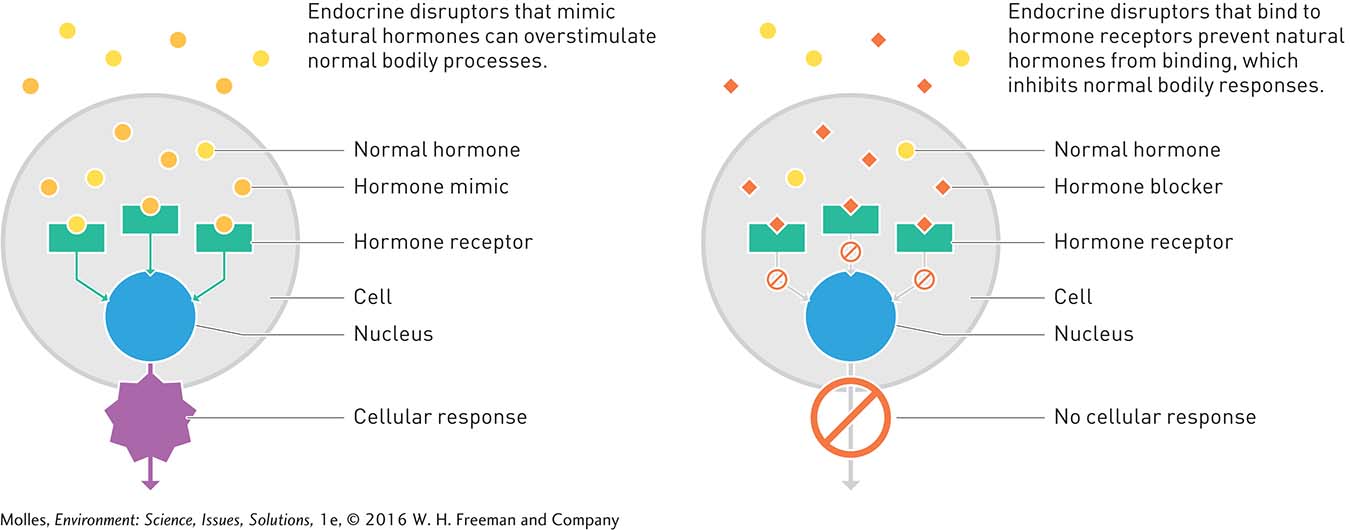11.4 Exposure to endocrine disruptors can affect the health of humans and other organisms
Many environmental health issues are worsened, or even caused, by our failure to apply basic biological information. For example, we know that predatory insects control populations of plant-
Endocrine Disruptors in the Environment
Hormones control many elements of the physiology and development of organisms, including embryonic growth and the storage and release of glucose for cellular metabolism. Certain chemicals called endocrine disruptors interfere with these processes (Figure 11.11). They can turn on the signals that hormones carry to cells, turn them off, or change the meaning of the message a hormone is carrying. All these actions can have drastic effects on tissue function. Interference with the development and function of sex organs is one of the most conspicuous effects of endocrine disruptors.


Why do humans continue to cause harm to the environment when we know in advance the consequences of our actions?
Many endocrine disruptors are by-
Androstenedione is unusual because it has a masculinizing effect; most endocrine disruptors are estrogen mimics that produce female characteristics. On a daily basis, we are surrounded by estrogen mimics: PCBs (polychlorinated biphenyls; see Chapter 13, page 392) are in the lubricants in our garages or basements, alkylphenols are in the detergents in our laundry rooms and beneath our kitchen sinks, styrenes are in cigarettes and automobile exhaust, and parabens are in cosmetics. Two estrogen mimics are especially pervasive—

How might the mosquitofish in the Fenholloway River and other species in other environments function as canaries once did in coal mines?
Bisphenol A (BPA) keeps polycarbonate plastics flexible and is used in epoxy resins. Infant bottles and plastic water bottles contain BPA, and BPA is present in the epoxy resins that coat the insides of food cans. Most human exposure to BPA comes from these sources. In 2012 the Food and Drug Administration (FDA) did not ban BPA from food containers because their studies showed that the human liver detoxifies BPA, thus concluding that humans have very low levels of BPA in their blood. The same studies also showed, however, that other animals are not able to detoxify BPA, so the FDA’s decision will allow the environmental effects of BPA to continue. Regardless of the decision, great demand among consumers for BPA-
The natural estrogen that women produce is excreted in urine, and the synthetic estrogen found in birth control pills is not completely broken down in sewage treatment plants. Consequently, the sewage effluent that is released into lakes, rivers, or the sea contains mixtures of these estrogens, which have a feminizing effect on aquatic organisms. Feminized male fish have been found in rivers even several kilometers downstream from the discharge pipes of sewage treatment plants.

What might be some long-
The list of species that have been feminized by environmental estrogens is long. It includes aquatic species (fish, frogs, salamanders, turtles, and alligators); terrestrial birds; mammals, invertebrates as well as vertebrates; and marine species (harbor seals and harp seals), including freshwater forms. Human males are not immune to the effects of environmental estrogens; the average sperm count of men in Europe and the United States has decreased by about 50% since 1950. Because these environmental estrogens affect so many species, including humans, it’s clear that the hormones and receptors of these organisms must have similar structures.
Think About It
Where are endocrine disruptors found and how are people exposed to them?
What effects do endocrine disruptors have on organisms?
If endocrine disruptors are known to have such wide-
ranging negative impacts, why do we continue to release them into the environment?